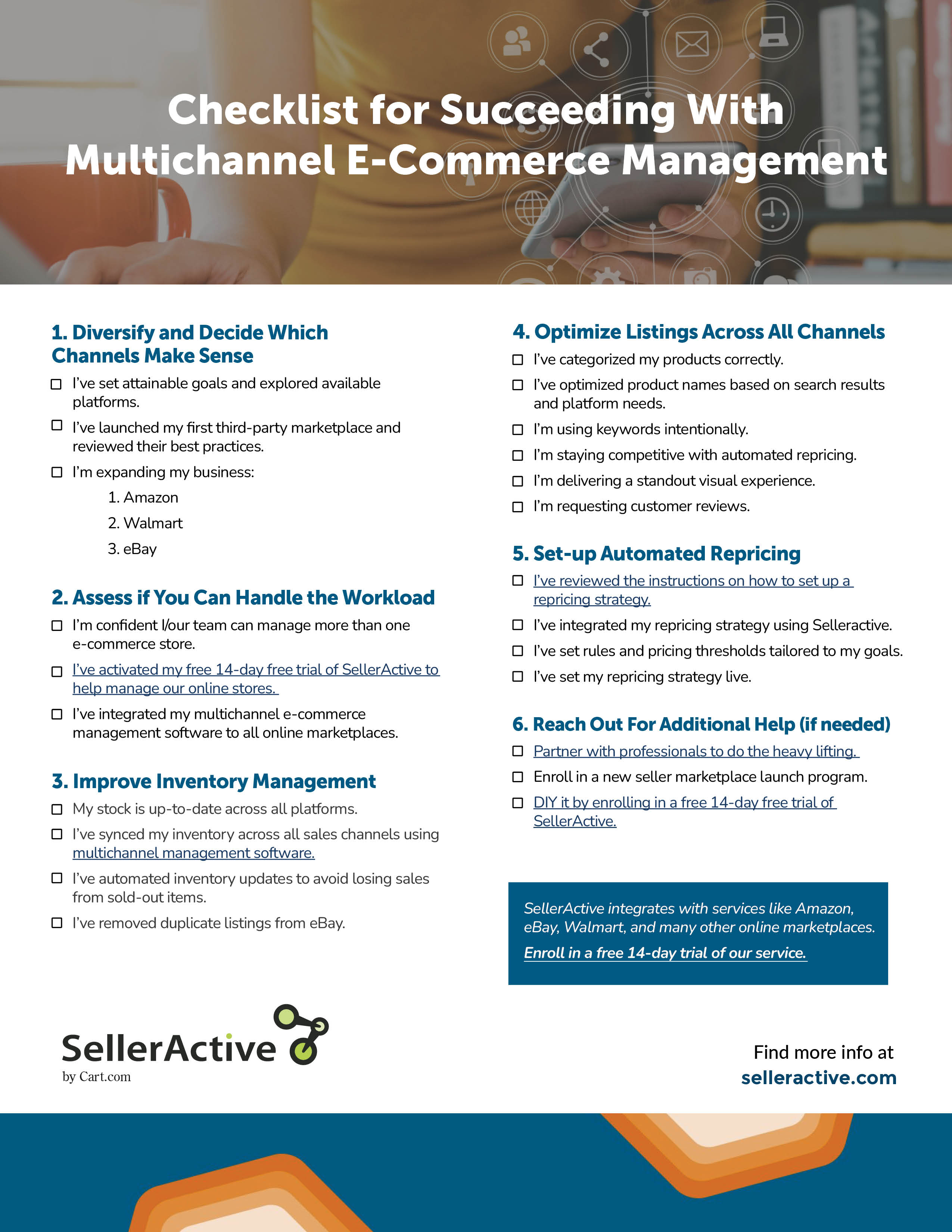We are so excited to see so many businesses discover success beyond their website by taking a multichannel approach. Still, we want to ensure our readers are ready to take the next step before getting in over their heads.
First, think of adding more sales channels like a portfolio. For example, use your website as your primary sales channel and marketplaces like Amazon, Walmart, or eBay for brand awareness, retention, or customer acquisition. How you manage those platforms together is paramount to success and is one of the best ways to reach new customers.
Doing it poorly often results in lost sales, customer frustration, tainted brand experiences, or worse. The easiest way to do it well is using a multichannel management tool for e-commerce. Once you’ve decided to expand to other online channels, how do you maintain success?
1. Diversify and Decide Which Channels Make Sense 
We love seeing business owners looking to extend their reach to multiple storefronts. We often recommend Amazon or Walmart as your primary third-party e-commerce options when considering your first expansion. Then, explore eBay as a third option if you've mastered one or both.
So, to build on this tip for selling online here’s the order we recommend if you’re starting out:
- Amazon: Amazon is the clear leader in its space by boasting 300 - 600 million active monthly users. It’s currently the most accessible online marketplace and continues to help hundreds of e-commerce businesses grow beyond their websites.
- Walmart: The Walmart Marketplace has become one of the fastest growing e-commerce marketplaces and averages 400 million monthly online shoppers. We love Walmart because it has a loyal customer base, which grants online businesses access to shoppers devoted to their brand. It’s also easier to stand out in their marketplace compared to Amazon.
- eBay: They have over 159 million active users. It offers business accounts for sole proprietors and e-commerce companies. These accounts are fantastic because they provide sellers with the tools for running an eBay store, from fulfillment to inventory management.
2. Plan for E-Commerce Management Time
Full disclosure: expanding your business to another online marketplace takes dedication and expertise within the spaces you reach. Unfortunately, many folks underestimate the time and effort it takes to update, manage, or deliver a consistent to great multichannel e-commerce experience. Some also consider the nuances of each platform before launching.
The good news is that you don't have to do it alone. Selling on your own site, Amazon, and beyond simultaneously is simplified when using multichannel management software designed for e-commerce businesses.
3. Remember that Inventory Management is Tied to Success
When you add another sales channel to your portfolio, you’re introducing another layer of challenges regarding inventory management. Remember that having a poorly managed online stockroom can lead to lost sales, customer complaints, or worse. As a tip for selling online, use the right tools made for e-commerce to succeed.
We emphasize the importance of having a multichannel inventory management solution because it helps e-commerce businesses avoid those issues. In turn, having one tool that automatically updates inventory levels while allowing you to make bulk updates and bundle products has become the easiest way to avoid lost sales and consumer confusion due to oversold items, duplicate listings, or other problems altogether.
4. Optimize Listings Across All Channels 
Play to the strengths of your new marketplace by understanding their rules, such as Walmart SEO, helps your product listings rank and be seen by customers. As a general tip for selling online, you should always use the following best practices across every e-commerce store:
- Categorize your products correctly
- Optimize product names based on search results and platform needs
- Use keywords intentionally
- Stay competitive with automated repricing
- Delivering a standout visual experience
- Request customer reviews
5. Embrace Automated Repricing
Competing for the Buy Box by manually updating listings is confusing and time-consuming. It’s also nearly impossible to do well if you don’t have access to quality data or have pricing software that uses an algorithm that does it for you.
In addition to saving time, the advantages of having an automated repricing strategy allows you to capture the buy box 72% of the time on average. It also helps you stay consistent, competitive, and strategic across all of your marketplaces.
So, how does it work? Automated repricing works by using software—or tools for e-commerce—to reprice an item automatically by evaluating competitor data and products or specific conditions you set. Meaning, you can set thresholds on pricing and inventory levels to avoid selling your products at a loss.
6. Don’t Be Afraid to Ask for Help or Use Software 
If you wish to explore more tools designed for e-commerce businesses that take the guesswork out of managing several online storefronts, let our professionals do the work for you. We offer new seller marketplace launch programs, inventory clean up services, and other enriching ways that support your growth that is handled by our team.
Additionally, we hope you enjoyed our best practices for selling your products online across multiple channels. If you choose to go it alone, we also provide a free 14-day trial of SellerActive to get started.
DOWNLOAD OUR CHECKLIST: CHECKLIST FOR SUCCEEDING WITH MULTICHANNEL E-COMMERCE MANAGEMENT
